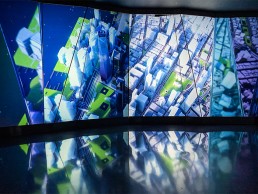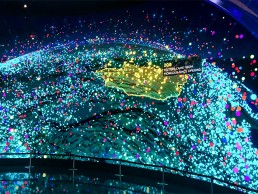This website uses cookies so that we can provide you with the best user experience possible. Cookie information is stored in your browser and performs functions such as recognising you when you return to our website and helping our team to understand which sections of the website you find most interesting and useful.
One World Observatory Visitor Experience
ProjectOne World Observatory Visitor ExperienceLocationManhattan, New YorkManufacturers Planar (USA), RealMotion (Canada/USA)Lighting DesignerFLOAT4 (Canada/USA)InstallerElectrosonic (USA)Submitted by FLOAT4
The One World Observatory, run by LEGENDS Hospitality, has welcomed more than 10.7 million guests since it opened in May 2015. Four digital installations act as a prelude to the Observatory experience; building anticipation from when guests enter the Global Welcome Center, to when they ride the SkyPods up to the observation decks, located on the 100th, 101st and 102nd floors. FLOAT4’s objectives were to streamline the customer journey and refresh the digital installations.
The result was an explorative voyage that connects each visitor’s origins to the future of the One World Trade Center. The four installations represent points in time, intertwining the timeline of Lower Manhattan to that of the visitor’s. The Reflection Screen, for example, serves as a visual introduction to the One World Trade Center in the present day and helps situate the visitors as to where they are in the city. The Portal Wall, right before the SkyPods, focusses on the future of the surrounding area and its changing skyline. The aesthetic of each piece becomes more and more futuristic as we travel through time.
The largest of the four installations is the Welcome Wall – a 1,142 ft wide x 218 ft high LED video wall at the entrance hall. The content displayed oscillates between a broader view of the world and a portrait of the United States, conveying a global connectedness via the visitor’s journeys to the One World experience.
The Horizon Grid connects the visitors to the history of the area by highlighting events that have shaped it, such as the city’s beginnings as Mannahatta and Thomas Edison’s ‘Light Bulb’ moment. The three-minute piece has a defined language of layouts, colours and historical images to differentiate between the events. FLOAT4 met with One World Tour Ambassadors to gain insight on which landmarks visitor’s asked about at the observation deck, and on the history of the area.
The installations leading up to the experience deliver the necessary information and the right ambiance to take in the views at the top of the One World Observatory. FLOAT4’s content sets the stage for a quintessential New York moment.
A majority of the installation challenges were brought upon by the travel restrictions. The most recurring challenge came from data transfers and rendering. With team members in multiple locations across Canada, and one based in the United States, the team engineered a workflow that allowed collaboration on the terabyte-sized content pieces.
FLOAT4 relied heavily on pre-visualisation techniques to ensure that the narrative and the quality of the visitor’s experience was consistent throughout the space. The team rebuilt the space in the Unreal Game Engine and viewed it in Oculus Rift 2 and Oculus Quest headsets to make design decisions from the safety of their own homes.
Each installation had its own technical specifications, which meant designing four pieces of content with their own irregularities. The team took advantage of the different specifications by creating ‘for‘ the installations, rather than ‘despite of.’
For example, the Welcome Wall is composed of two adjoining Planar TVF Series LED video walls that create one digital canvas around 1,142 ft wide x 218 ft high, and a curved floor-to-ceiling Planar TVF Series LED video wall installation with a 1.8mm pixel pitch (TVF1.8). The wall becomes a ‘global guestbook’ by using real-time data collected from ticket scans; for every visitor that scans a ticket, a greeting in their native language appears on the wall. An interactive particle system mirrors the movement of visitors using two Microsoft Azure Kinects. To optimise the installation’s interactivity for different entrance hall capacities, the system has three different pacing modes. The experience switches between the modes by reading the number of ticket scans throughout the day. It’s also customisable; if there are VIPs or special events, the greetings can be changed and personalised by the client.
The Horizon Grid is another example of the unusual technical specifications that FLOAT4 had to work with. The canvas is 38,000 native pixels wide, and consists of 145 LED screens of various depths. When creating content, the team had to design with the views from the different angles within the queuing experience. On the other hand, the triangular LED screens for the Reflection Screen installation inspired the team to design content with a ‘trompe l’oeil’ effect; the ambient piece gives the impression of a broken glass effect while providing a succinct view of New York City focused predominantly on Lower Manhattan.
FLOAT4 managed to successfully craft a globally accessible narrative through content and soundscaping, visually and sonically connecting all four installations to each other.



